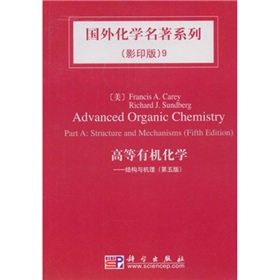国外化学名著系列9·高等有机化学:结构与机理 电子书下载 PDF下载

内容简介
《高等有机化学:结构与机理(第5版)》自从1997年面世以来,《高等有机化学》作为学科首选教材的地位一直没有动摇过,广泛地覆盖了有机化合物的结构、反应活性及合成。她的第五版相对2001年出版的第四版进行了大幅度的修订,更新了学科发展的相关资料,内容组织更加清晰明朗,特别是计算化学部分。Part A从化合物结构和立体化学基础概念讲起,涉及有机化学反应热力学和动力学的方方面面。主要反应类型涵盖亲核取代反应、加成反应、碳负离子和羰基化学反应、芳环取代反应、周环反应、自由基反应和光化学反应。每章后附有习题精选及解答习题的推荐参考文献。
·查看全部>>
目录
Preface
Acknowledgment and Personal Statement
Introduction
Chapter 1 Chemical Bonding and Molecular Structure
Introduction
1.1 Description of Molecular Structure Using Valence Bond Concepts
1.1.1 Hybridization
1.1.2 The Origin of Electron-Electron Repulsion
1.1.3 Electronegativity and Polarity
1.1.4 Electronegativity Equalization
1.1.5 Differential Electronegativity of Carbon Atoms
1.1.6 Polarizability, Hardness, and Softness
1.1.7 Resonance and Conjugation
1.1.8 Hyperconjugation
1.1.9 Covalent and van der Waals Radii of Atoms
1.2 Molecular Orbital Theory and Methods
1.2.1 The Hiickel MO Method
1.2.2 Semiempirical MO Methods
1.2.3 Ab Initio Methods
1.2.4 Pictorial Representation of MOs for Molecules
1.2.5 Qualitative Application of MO Theory to Reactivity: Perturbational MO Theory and Frontier Orbitals
1.2.6 Numerical Application of MO Theory
1.3 Electron Density Functionals
1.4 Representation of Electron Density Distribution
1.4.1 Mulliken Population Analysis
1.4.2 Natural Bond Orbitals and Natural Population Analysis
1.4.3 Atoms in Molecules
1.4.4 Comparison and Interpretation of Atomic Charge Calculations
1.4.5 Electrostatic Potential Surfaces
1.4.6 Relationships between Electron Density and Bond Order
Topic 1.1 The Origin of the Rotational (Torsional) Barrier in Ethane and Other Small Molecules
Topic 1.2 Heteroatom Hyperconjugation (Anomeric Effect) in Acyclic Molecules
Topic 1.3 Bonding in Cyclopropane and Other Small Ring Compounds
Topic 1.4 Representation of Electron Density by the Laplacian Function
Topic 1.5 Application of Density Functional Theory to Chemical Properties and Reactivity
T 1.5.1 DFT Formulation of Chemical Potential, Electronegativity, Hardness and Softness,and Covalent and van der Waal Radii
T 1.5.2 DFT Formulation of Reactivity——The Fukui Function ..
T 1.5.3 DFT Concepts of Substituent Groups Effects
General References
Problems
Chapter 2 Stereoehemistry, Conformation, and Stereoselectivity.. "
Introduction
2.1 Configuration
2.1.1 Configuration at Double Bonds
2.1.2 Configuration of Cyclic Compounds
2.1.3 Configuration at Tetrahedral Atoms
2.1.4 Molecules with Multiple Stereogenic Centers
2.1.5 Other Types of Stereogenic Centers
2.1.6 The Relationship between Chirality and Symmetry
2.1.7 Configuration at Prochiral Centers
2.1.8 Resolution——The Separation of Enantiomers
2.2 Conformation
2.2.1 Conformation of Acyclic Compounds
2.2.2 Conformations of Cyclohexane Derivatives
2.2.3 Conformations of Carbocyclic Rings of Other Sizes
2.3 Molecular Mechanics
2.4 Stereoselective and Stereospecific Reactions
2.4.1 Examples of Stereoselective Reactions
2.4.2 Examples of Stereospecific Reactions
2.5 Enantioselective Reactions
2.5.1 Enantioselective Hydrogenation
2.5.2 Enantioselective Reduction of Ketones
2.5.3 Enantioselective Epoxidation of Allylic Alcohols
2.5.4 Enantioselective Dihydroxylation of Alkenes
2.6 Double Stereodifferentiation: Reinforcing and Competing Stereoselectivity
Chapter 3 Strucral Effects on Stability and Reactivity
Chapter 4 Nucleophilic Substitution
Chapter 5 Polar Addition and Elimination Reactions
Chapter 6 Carbanions and Other Carbon Nucleophiles
Chapter 7 Addition,Condensation and Substitution Reactions of Carbonyl Compounds
Chapter 8 Aromatictity
Chapter 9 Aromatic Substitution
Chapter 10 Concerted Pericyclic Reactions
Chapter 11 Free Radical Reactions
Chapter 12 Photochemistry
References to Problems
Index
Acknowledgment and Personal Statement
Introduction
Chapter 1 Chemical Bonding and Molecular Structure
Introduction
1.1 Description of Molecular Structure Using Valence Bond Concepts
1.1.1 Hybridization
1.1.2 The Origin of Electron-Electron Repulsion
1.1.3 Electronegativity and Polarity
1.1.4 Electronegativity Equalization
1.1.5 Differential Electronegativity of Carbon Atoms
1.1.6 Polarizability, Hardness, and Softness
1.1.7 Resonance and Conjugation
1.1.8 Hyperconjugation
1.1.9 Covalent and van der Waals Radii of Atoms
1.2 Molecular Orbital Theory and Methods
1.2.1 The Hiickel MO Method
1.2.2 Semiempirical MO Methods
1.2.3 Ab Initio Methods
1.2.4 Pictorial Representation of MOs for Molecules
1.2.5 Qualitative Application of MO Theory to Reactivity: Perturbational MO Theory and Frontier Orbitals
1.2.6 Numerical Application of MO Theory
1.3 Electron Density Functionals
1.4 Representation of Electron Density Distribution
1.4.1 Mulliken Population Analysis
1.4.2 Natural Bond Orbitals and Natural Population Analysis
1.4.3 Atoms in Molecules
1.4.4 Comparison and Interpretation of Atomic Charge Calculations
1.4.5 Electrostatic Potential Surfaces
1.4.6 Relationships between Electron Density and Bond Order
Topic 1.1 The Origin of the Rotational (Torsional) Barrier in Ethane and Other Small Molecules
Topic 1.2 Heteroatom Hyperconjugation (Anomeric Effect) in Acyclic Molecules
Topic 1.3 Bonding in Cyclopropane and Other Small Ring Compounds
Topic 1.4 Representation of Electron Density by the Laplacian Function
Topic 1.5 Application of Density Functional Theory to Chemical Properties and Reactivity
T 1.5.1 DFT Formulation of Chemical Potential, Electronegativity, Hardness and Softness,and Covalent and van der Waal Radii
T 1.5.2 DFT Formulation of Reactivity——The Fukui Function ..
T 1.5.3 DFT Concepts of Substituent Groups Effects
General References
Problems
Chapter 2 Stereoehemistry, Conformation, and Stereoselectivity.. "
Introduction
2.1 Configuration
2.1.1 Configuration at Double Bonds
2.1.2 Configuration of Cyclic Compounds
2.1.3 Configuration at Tetrahedral Atoms
2.1.4 Molecules with Multiple Stereogenic Centers
2.1.5 Other Types of Stereogenic Centers
2.1.6 The Relationship between Chirality and Symmetry
2.1.7 Configuration at Prochiral Centers
2.1.8 Resolution——The Separation of Enantiomers
2.2 Conformation
2.2.1 Conformation of Acyclic Compounds
2.2.2 Conformations of Cyclohexane Derivatives
2.2.3 Conformations of Carbocyclic Rings of Other Sizes
2.3 Molecular Mechanics
2.4 Stereoselective and Stereospecific Reactions
2.4.1 Examples of Stereoselective Reactions
2.4.2 Examples of Stereospecific Reactions
2.5 Enantioselective Reactions
2.5.1 Enantioselective Hydrogenation
2.5.2 Enantioselective Reduction of Ketones
2.5.3 Enantioselective Epoxidation of Allylic Alcohols
2.5.4 Enantioselective Dihydroxylation of Alkenes
2.6 Double Stereodifferentiation: Reinforcing and Competing Stereoselectivity
Chapter 3 Strucral Effects on Stability and Reactivity
Chapter 4 Nucleophilic Substitution
Chapter 5 Polar Addition and Elimination Reactions
Chapter 6 Carbanions and Other Carbon Nucleophiles
Chapter 7 Addition,Condensation and Substitution Reactions of Carbonyl Compounds
Chapter 8 Aromatictity
Chapter 9 Aromatic Substitution
Chapter 10 Concerted Pericyclic Reactions
Chapter 11 Free Radical Reactions
Chapter 12 Photochemistry
References to Problems
Index
同类热门电子书下载更多
Copyright © 2025 by topbester.com.
All Rights Reserved.
沪ICP备14027842号-1
All Rights Reserved.
沪ICP备14027842号-1